Abstract
In China, traditional Chinese medicine (TCM) has been widely used for coronavirus infectious disease 2019 (COVID‐19) prevention, treatment, and recovery and has played a part in the battle against the disease. A variety of TCM treatments have been recommended for different stages of COVID‐19. But, to the best of our knowledge, a comprehensive database for storing and organizing anti‐COVID TCM treatments is still lacking. Herein, we developed TCM2COVID, a manually curated resource of anti‐COVID TCM formulas, natural products (NPs), and herbs. The current version of TCM2COVID (1) documents over 280 TCM formulas (including over 300 herbs) with detailed clinical evidence and therapeutic mechanism information; (2) records over 80 NPs with detailed potential therapeutic mechanisms; and (3) launches a useful web server for querying, analyzing and visualizing documented formulas similar to those supplied by the user (formula similarity analysis). In summary, TCM2COVD provides a user‐friendly and practical platform for documenting, querying, and browsing anti‐COVID TCM treatments, and will help in the development and elucidation of the mechanisms of action of new anti‐COVID TCM therapies to support the fight against the COVID‐19 epidemic. TCM2COVID is freely available at http://zhangy-lab.cn/tcm2covid/.
Keywords: COVID‐19, database, herb, natural product, traditional Chinese medicine
TCM2COVID documents over 280 traditional Chinese medicine formulas (including over 300 herbs) with detailed clinical evidence and therapeutic mechanism information; TCM2COVID records over 80 natural products with detailed potential therapeutic mechanisms; TCM2COVID launches a useful web server for querying, analyzing, and visualizing documented formulas similar to those supplied by the user (formula similarity analysis).
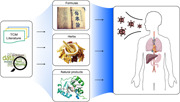
Highlights
TCM2COVID documents over 280 TCM formulas (including over 300 herbs) with detailed clinical evidence and therapeutic mechanism information.
TCM2COVID records over 80 NPs with detailed potential therapeutic mechanisms.
TCM2COVID launches a useful web server for querying, analyzing, and visualizing documented formulas similar to those supplied by the user (formula similarity analysis).
INTRODUCTION
The coronavirus infectious disease 2019 (COVID‐19) pandemic has lasted for more than 2 years and is a serious threat to global public health [1, 2, 3]. The highly contagious BA.2 sub‐variant of omicron has been surging in many countries, and as of 1 May 2022, over 500 million confirmed cases and over six million deaths have been reported globally [4, 5]. Nevertheless, medical workers and scientists all over the world are working tirelessly to combat the epidemic [5, 6]. In China, traditional Chinese medicine (TCM) has been widely used for COVID‐19 prevention, treatment, and recovery and has played a part in the battle against the disease [1, 7, 8, 9]. A variety of TCM formulas such as “3 medicines (Jinhua Qinggan granule, Lianhua Qingwen capsule/granule, and Xuebijing injection)” and “3 formulations (Qingfei Paidu, Huashi Baidu, and Xuanfei Baidu granule)” have been recommended for different stages of COVID‐19, covering the asymptomatic infection period, clinical treatment period, and recovery period [10, 11]. In addition, some Asian countries such as South Korea and Japan have fully or partially incorporated TCM treatments [12, 13].
At present, a series of clinical trial studies from multiple hospitals in China have been launched to investigate the efficacy and safety of TCM therapies for COVID‐19. Accumulated clinical evidence shows that TCM has a significant positive impact on COVID‐19 patients, by reducing clinical symptoms, promoting recovery, improving chest images, and inhibiting disease progression [14, 15]. Meanwhile, an increasing number of studies on therapeutic mechanisms have shown that TCM treatment not only targets the virus but also improves the whole body [16, 17, 18, 19]. In addition, many natural products (NPs) and derivatives (such as Proscillaridin A, Scutellarein, Phillyrin, Quercetagetin, and Dihydromyricetin) from TCM herbs have been shown to exhibit activity against SARS‐Cov‐2 by in vitro assays and/or in silico methods (network pharmacology analysis, molecular docking, and virtual screening, etc.) [20, 21, 22, 23, 24, 25]. Summarizing the evidence from current studies, the effects and mechanisms of the TCM therapies mainly include the following: inhibiting virus invasion and replication by targeting key molecules (the S protein, ACE2, 3CLpro, PLpro and RdRp, TMPRSS2, etc.); regulating immune and inflammatory responses by targeting various immune factors; and improving complications and symptoms (Figure 1) [1, 26, 27, 28, 29].
Figure 1.
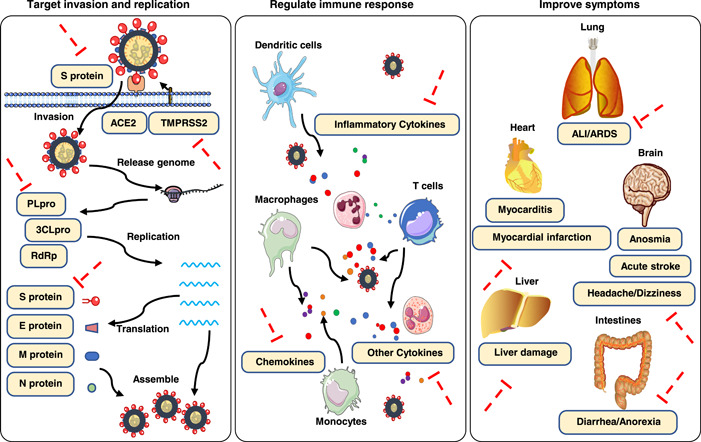
Therapeutic mechanisms of TCM treatments. (1) inhibiting virus invasion and replication by targeting key molecules; (2) regulating immune and inflammatory responses by targeting various immune factors; (3) improving complications and symptoms. TCM, traditional Chinese medicine.
Recently, some studies began to collect the applied formulas of TCM, systematically explore the potential mechanisms underlying the TCM recipes, and screen the key herbs and ingredients for combating COVID‐19 [16, 30]. However, to the best of our knowledge, a comprehensive database for storing and organizing anti‐COVID TCM treatments is still lacking. Herein, we developed TCM2COVID, a manually curated resource of anti‐COVID TCM formulas, NPs, and herbs, which aims to provide a platform for the efficient manipulation, browsing, and analysis of anti‐COVID TCM treatments. TCM2COVID is freely available at http://zhangy-lab.cn/tcm2covid/.
RESULTS
Web interface
TCM2COVID provides a convenient web interface that enables users to retrieve anti‐COVID TCM treatment data, and a web server has been developed for formula similarity analysis (Figure 2). Via the navigation bar, users can easily link to the Search, Download, Webserver, and Statistics pages. The Search page enables users to easily query TCM formulas, herbs, and NPs by inputting keywords (English, Chinese, Pinyin, or Latin name). On the Homepage, users also can browse the TCM formulas, herbs, and NPs data in the database by clicking on the corresponding hyperlink. The statistics for the TCM formulas, herbs, and NPs are presented on the Statistics page. All the data can be downloaded from the Download page. For user convenience, TCM2COVID features a Webserver page for formula similarity analysis. Users can upload herb lists of their own formulas to perform formula similarity analysis, and the results are presented as a bubble chart on the Result page. In addition, TCM2COVID provides detailed instructions and an example on the Help page.
Figure 2.
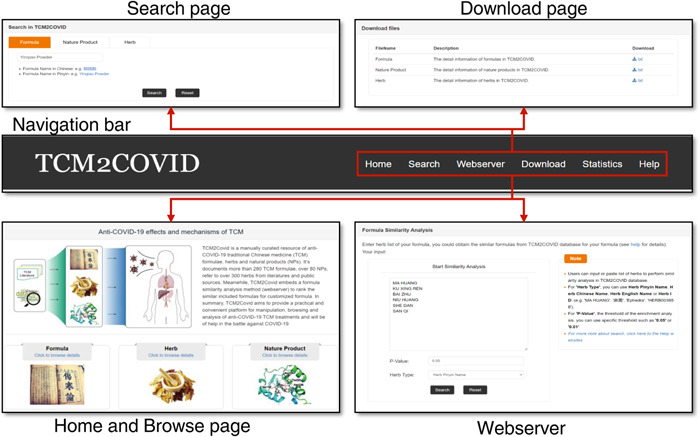
Web interface of TCM2COVID. Users can link to the Search, Download, Webserver, Statistics, and Help pages via the navigation bar.
Data querying and results presentation
To make it convenient for users to query and browse data, TCM2COVID provides three different search methods on the Search page, including “Formula Search” (searching a formula by inputting its Chinese name or Pinyin name), “Natural Product Search” (searching an NP by inputting its English name, Molecular formula, or PubChem CID) and “Herb Search” (searching a herb by inputting its English name, Chinese name, or Pinyin name) (Figure 3). A summary of the search results is presented in a table on the Result page. Detailed information on certain formulas, NPs, and herb entries can be viewed on the Detail page by clicking “more.” For formula entry, the Detail page presents basic information (name, dosage form, herbs contained in this formula, etc.), COVID Treatment Information (virus, IC50 (EC50) or dosage, improvement in symptoms, potential mechanism, etc.) and references information. For NP entry, the Detail page presents the basic information (NP name, 2D‐Structure, molecular formula, SMILES, original herbs, etc.), COVID Treatment Information (virus, effects, dosage, in silico method, etc.), and references information. For herb entry, the Detail page presents basic information (name, properties, meridians, indications, etc.) and a related ingredients list. Meanwhile, TCM2COVID provides an embedded network plot web tool on the Detail page to present the relationships between herbs and formulas or NPs. Users can highlight interactions of interest by moving the cursor over the diagram. Additionally, detailed instructions for querying, browsing, and analyzing anti‐COVID TCM treatments have been provided on the website of the database.
Figure 3.
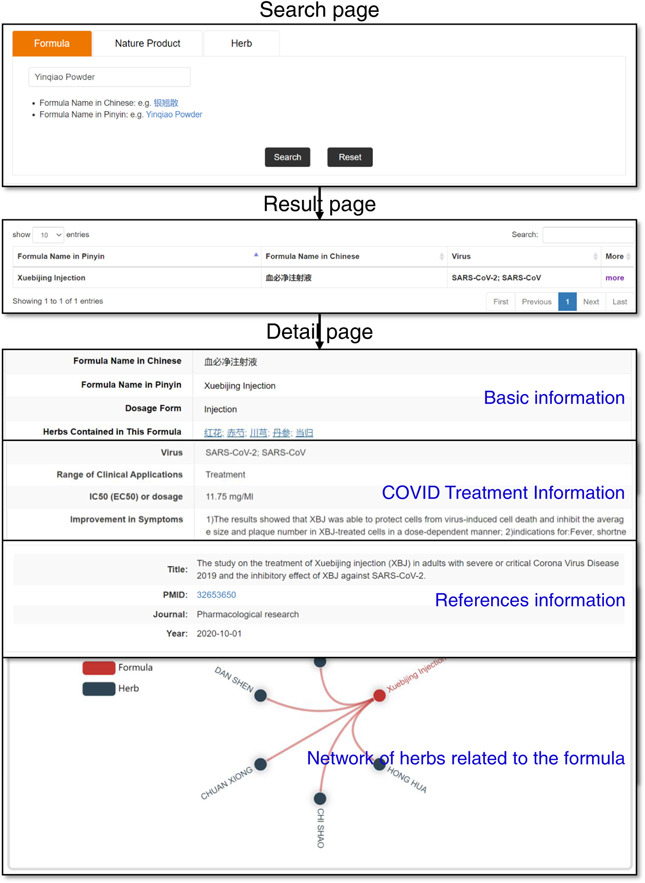
The Search page, Result page and Detail page (use Xuebijing Injection as an example)
Webserver for formula similarity analysis
For user convenience, TCM2COVID launches a webserver for formula similarity analysis (Figure 4). First, users can fill out the herb list of the queried formula in the query window (inputting the herb's English name, Chinese name, Pinyin name, or ID). Users can also determine the threshold of the p value for Fisher's exact test. When the analysis is complete, the results are presented as a bubble plot on the Result page. The size of each bubble represents the FS score, and the color of the bubble represents the significance of the FS score. The results table containing FS scores and p values can be downloaded from the Result page.
Figure 4.
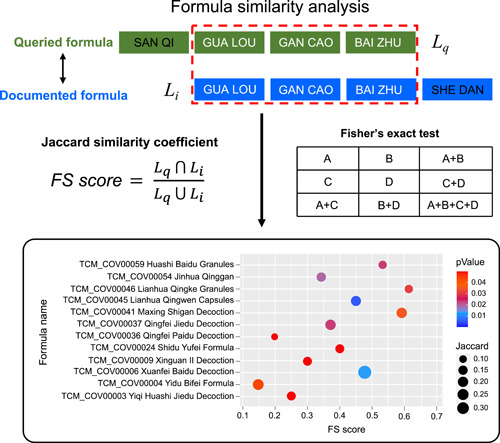
Schematic diagram of the webserver for formula similarity analysis
DISCUSSION
In China, TCM is playing an important role in the global fight against COVID‐19, and some studies begin to investigate the integrative mechanisms of TCMs by systematically analyzing the anti‐COVID‐19 TCM recipes [16, 30, 31]. Of which, Zhang et al. developed a comprehensive platform named soFDA, which integrated a network of disease–syndrome–TCM formula associations, and provided a series of elaborate web tools for TCM analysis. Users could query and analyze the potential COVID‐19 TCM formulas using the platform. However, a specialized database for storing and organizing anti‐COVID TCM treatments is still lacking. Herein, we developed TCM2COVID, a manually curated resource of anti‐COVID TCM formulas, NPs, and herbs. We believe that the TCM2COVID database will be a useful resource for the systematic studies and tools related to TCM and COVID‐19 therapy.
Although a series of TCM therapies have been approved to treat COVID‐19 [32, 33], the safety and effectiveness of TCM are still debated in the global medical field [34, 35, 36]. Due to a lack of high‐quality and rigorously peer‐reviewed clinical trials and poor understanding of the mechanism of action of TCM therapies, some studies suggest that the use of herbal drugs to treat COVID‐19 should be with caution [13, 35, 37]. Unfortunately, the argument has become political recently, making TCM an issue of political claims, which distorts what medicine should focus on and has hampered efforts to fight against COVID‐19 [38]. Despite this, there are many studies that have called for breaking down boundaries between Eastern and Western medicine and suggest that a proper combination of TCM and Western medicine could better control the disease progression and post‐disease syndromes [39, 40, 41, 42, 43, 44]. Herein, as part of the efforts for probing these issues, TCM2COVID, a comprehensive database, documents the detailed information on anti‐COVID TCM treatments and is undoubtedly a useful toolkit to help settle the controversy surrounding the effects and mechanisms of TCM therapies.
TCM2COVID still has some limitations. First, all formulas documented in the database are lacking information on herb proportion and importance (such as the principle of “monarch, ministerial, assistant and guide”), because most of original sources didn't provide these data. Meanwhile, some TCMs usually treat COVID‐19 in combination with western medicine, which is also an important part of the COVID‐19 treatments and should be collected in the database. Therefore, to remedy these data limitations, we will continue to collect and sort this information and update TCM2COVID in the future.
The current version of TCM2COVID documents TCM formulas and NPs from the literature and public sources. First, knowledge of the potential therapeutic mechanisms of the documented TCM therapies stored in TCM2COVID could provide suggestions for the pharmacological study and functional characterization of new anti‐COVID TCM treatments. Second, the continued accumulation of clinical trial data and outcomes of anti‐COVID TCM treatments will definitely provide the basis for clinical research and therapy for the disease. In addition, for user convenience, TCM2COVID launches a webserver for formula similarity analysis, which provides a useful platform for querying, analyzing, and visualizing documented formulas similar to those supplied by the user and thus definitely could be a useful tool for a basic and clinical study on new anti‐COVID TCM formulas.
CONCLUSION
In summary, TCM2COVID documents over 280 TCM formulas (including over 300 herbs) with detailed clinical evidence and therapeutic mechanism information, and records over 80 NPs with detailed potential therapeutic mechanisms. It provides a user‐friendly and practical platform for documenting, querying, and browsing anti‐COVID TCM treatments and will help in the development and elucidation of the mechanisms of action of new anti‐COVID TCM therapies to support the fight against the COVID‐19 epidemic.
METHODS
Anti‐COVID TCM formulas
The TCM formulas in the TCM2COVID database were curated manually from peer‐reviewed studies and public sources, including national and local health commissions, hospitals, and TCM research institutes (Figure 5A). A total of 287 TCM formulas were collected, including 109 established TCM formulas, 143 formulas from the “Diagnosis and Treatment Protocol for COVID‐19” guidelines recommended by different health commissions, and 35 formulas prescribed by the “Master of TCM.” Detailed clinical evidence and therapeutic mechanism information, such as “potential mechanism,” “improvement in symptoms,” “IC50 (EC50) or dosage,” and “China Clinical Trial information (from Chinese Clinical Trial Registry (ChiCTR))” (Figure 5B), are also collected in the database. Moreover, 6 of the 287 TCM formulas have also been reported to be suitable for treating SARS.
Figure 5.

Collection, annotation, and organization of the TCM formulas, herbs, and NPs data. (A) Schematic of the database architecture. It contains data collection, data organization, and data presentation. (B) Statistics, annotation, and organization of the TCM formulas, herbs, and NPs data. NP, natural product; TCM, traditional Chinese medicine.
Anti‐COVID NPs
The NPs in the TCM2COVID database were curated manually from peer‐reviewed studies (Figure 5A). A total of 84 NPs were collected; of these, 48 NPs showed anti‐SARS‐CoV‐2 effects, 29 NPs showed anti‐SARS‐CoV effects, 2 NPs showed anti‐MERS‐CoV effects, and 4 NPs showed both anti‐SARS‐CoV and anti‐SARS‐CoV‐2 effects, and 1 NP showed both anti‐MERS‐CoV and anti‐SARS‐CoV‐2 effects. We also collected information on the “potential mechanism” and “IC50 (EC50) or dosage” for the anti‐COVID NPs from the literature (Figure 5B). Moreover, 14 NPs that have recently been explored by in silico methods (network pharmacology analysis, molecular docking, and virtual screening, etc.) are also documented in the TCM2COVID database.
Anti‐COVID herbs
All the documented TCM formulas and NPs refer to 313 herbs. Information on “Properties,” “Meridians,” “Use Part,” “Indication,” and “Ingredients” was collected from the HERB database [45], SymMap database [46], TCMID 2.0 database [47] and ETCM database (Figure 5B) [48]. To unify the herbs and NPs from multiple resources into authoritative reference databases, the herbs in TCM2COVID were mapped to the HERB database (Herb id), and the NPs and the herb ingredients were mapped to the NCBI PubChem database (PubChem CID) [49].
Pipeline for formula similarity analysis
For user convenience, TCM2COVID launches a webserver for formula similarity analysis (Figure 4). First, TCM2COVID quantifies the similarity between queried formula q and documented formula i using the formula similarity (FS) score, which is calculated by the Jaccard similarity coefficient [50, 51]:
| (1) |
where L q is the herb list of queried formula q and L i is the herb list of documented formula i. Additionally, we estimated the significance of the similarity between the queried formula and the documented formula with Fisher's exact test.
Architecture
TCM2COVID is implemented using the HTML and PHP languages with the MySQL server. The interface component consists of web pages designed and implemented in HTML/CSS. It has been tested in Google Chrome, Firefox, and Internet Explorer web browsers.
AUTHOR CONTRIBUTIONS
Conceptualization: Yang Zhang, Kejun Deng, and Jian Huang. Investigation: Liping Ren, Yi Xu, Lin Ning, and Yuchen Li. Coding: Yi Xu and Yang Zhang. Data collection: Liping Ren, Xianrun Pan, Yang Zhang, Qi Zhao, Bo Pang, and Yuchen Li. Writing: Yang Zhang, Kejun Deng, and Jian Huang. Funding acquisition: Yang Zhang, Kejun Deng, and Jian Huang. All authors have read the final manuscript and approved it for publication.
CONFLICT OF INTEREST
The authors declare no conflict of interest.
ACKNOWLEDGMENTS
We thank the National Natural Science Foundation of China (62071099, 81872957, 82130112), Natural Science Foundation of Sichuan Province (2022NSFSC1610), and Basic and Applied Basic Research Fund of Guangdong Province (2019A1515110701).
Ren, Liping , Xu Yi, Ning Lin, Pan Xianrun, Li Yuchen, Zhao Qi, Pang Bo, et al. 2022. “TCM2COVID: A Resource of Anti‐COVID‐19 Traditional Chinese Medicine with Effects and Mechanisms.” iMeta 1, e42. 10.1002/imt2.42
Liping Ren, Yi Xu, and Lin Ning contributed equally to this study.
[Correction added on 12 August 2022, after first online publication: In the previous published version of the article, corresponding author address and affiliation had errors that are now corrected.]
Contributor Information
Jian Huang, Email: hj@uestc.edu.cn.
Kejun Deng, Email: dengkj@uestc.edu.cn.
Yang Zhang, Email: yangzhang@cdutcm.edu.cn, Email: zhy1001@alu.uestc.edu.cn.
DATA AVAILABILITY STATEMENT
All the data analyzed in the study are freely available at http://zhangy-lab.cn/tcm2covid/.
REFERENCES
- 1. Lyu, Ming , Fan Guanwei, Xiao Guangxu, Wang Taiyi, Xu Dong, Gao Jie, Ge Shaoqin, et al. 2021. “Traditional Chinese Medicine in COVID‐19.” Acta Pharmaceutica Sinica B 11: 3337–63. 10.1016/j.apsb.2021.09.008 [DOI] [PMC free article] [PubMed] [Google Scholar]
- 2. Li, Liyang , Huang Qihong, Wang Diane C., Ingbar David H., and Wang Xiangdong. 2020. “Acute Lung Injury in Patients With COVID‐19 Infection.” Clinical and Translational Medicine 10: 20–27. 10.1002/ctm2.16 [DOI] [PMC free article] [PubMed] [Google Scholar]
- 3. Lv, Hao , Shi Lei, Berkenpas Joshua William, Dao Fu‐Ying, Zulfiqar Hasan, Ding Hui, Zhang Yang, Yang Liming, and Cao Renzhi. 2021. “Application of Artificial Intelligence and Machine Learning for COVID‐19 Drug Discovery and Vaccine Design.” Briefings in Bioinformatics 22: bbab320. 10.1093/bib/bbab320 [DOI] [PMC free article] [PubMed] [Google Scholar]
- 4. Rahimi, Farid , and Abadi Amin Talebi Bezmin. 2022. “The Omicron Subvariant BA.2: Birth of a New Challenge During the COVID‐19 Pandemic.” International Journal of Surgery 99: 106261. 10.1016/j.ijsu.2022.106261 [DOI] [PMC free article] [PubMed] [Google Scholar]
- 5. Fan, Yao , Li Xiang, Zhang Lei, Wan Shu, Zhang Long, and Zhou Fangfang. 2022. “SARS‐CoV‐2 Omicron Variant: Recent Progress and Future Perspectives.” Signal Transduction and Targeted Therapy 7: 141. 10.1038/s41392-022-00997-x [DOI] [PMC free article] [PubMed] [Google Scholar]
- 6. Lavazza, Andrea , and Farina Mirko. 2020. “The Role of Experts in the Covid‐19 Pandemic and the Limits of Their Epistemic Authority in Democracy.” Frontiers in Public Health 8: 356. 10.3389/fpubh.2020.00356 [DOI] [PMC free article] [PubMed] [Google Scholar]
- 7. Huang, Kai , Zhang Pan, Zhang Zhenghao, Youn Ji Youn, Wang Chen, Zhang Hongchun, and Cai Hua. 2021. “Traditional Chinese Medicine (TCM) in the Treatment of COVID‐19 and Other Viral Infections: Efficacies and Mechanisms.” Pharmacology & Therapeutics 225: 107843. 10.1016/j.pharmthera.2021.107843 [DOI] [PMC free article] [PubMed] [Google Scholar]
- 8. Ren, Jun‐Ling , Zhang Ai‐Hua, and Wang Xi‐Jun. 2020. “Traditional Chinese Medicine for COVID‐19 Treatment.” Pharmacological Research 155: 104743. 10.1016/j.phrs.2020.104743 [DOI] [PMC free article] [PubMed] [Google Scholar]
- 9. Li, Heng , Yang Li, Liu Fei‐fei, Ma Xin‐na, He Pei‐lan, Tang Wei, Tong Xian‐kun, and Zuo Jian‐ping. 2020. “Overview of Therapeutic Drug Research for COVID‐19 in China.” Acta Pharmacologica Sinica 41: 1133–40. 10.1038/s41401-020-0438-y [DOI] [PMC free article] [PubMed] [Google Scholar]
- 10. Lee, Beom‐Joon , Lee Ju Ah, Kim Kwan‐Il, Choi Jun‐Yong, and Jung Hee‐Jae. 2020. “A Consensus Guideline of Herbal Medicine for Coronavirus Disease 2019.” Integrative Medicine Research 9: 100470. 10.1016/j.imr.2020.100470 [DOI] [PMC free article] [PubMed] [Google Scholar]
- 11. Zhang, Shuo , Yang Zhen, Chen Zhen‐Lin, Li Zhuo‐Ning, Yue Shi‐Jun, Li Jia‐Jia, Tang Yu‐Ping. 2022. Efficacy and Safety of “Three Chinese Patent Medicines and Three TCM Prescriptions” for COVID‐19: A Systematic Review and Network Meta‐Analysis. Evidence‐Based Complementary and Alternative Medicine 2022: 4654793. 10.1155/2022/4654793 [DOI] [PMC free article] [PubMed] [Google Scholar]
- 12. Silveira, Dâmaris , Prieto‐Garcia Jose Maria, Boylan Fabio, Estrada Omar, Fonseca‐Bazzo Yris Maria, Jamal Claudia Masrouah, Magalhães Pérola Oliveira, et al. 2020. “COVID‐19: Is There Evidence for the Use of Herbal Medicines as Adjuvant Symptomatic Therapy?” Frontiers in Pharmacology 11: 581840. 10.3389/fphar.2020.581840 [DOI] [PMC free article] [PubMed] [Google Scholar]
- 13. Wang, Yangzihan , Greenhalgh Trisha, Wardle Jon, and Rapid Review Team Oxford T. C. M.. 2022. “Chinese Herbal Medicine (“3 Medicines and 3 Formulations”) for COVID‐19: Rapid Systematic Review and Meta‐Analysis.” Journal of Evaluation in Clinical Practice 28: 13–32. 10.1111/jep.13614 [DOI] [PMC free article] [PubMed] [Google Scholar]
- 14. Ren, Wei , Liang Pan, Ma Yue, Sun Qin, Pu Qingrong, Dong Li, Luo Gang, et al. 2021. “Research Progress of Traditional Chinese Medicine Against COVID‐19.” Biomedicine & Pharmacotherapy 137: 111310. 10.1016/j.biopha.2021.111310 [DOI] [PMC free article] [PubMed] [Google Scholar]
- 15. Kang, Xiaomin , Jin De, Jiang Linlin, Zhang Yuqing, Zhang Yuehong, An Xuedong, Duan Liyun, et al. 2022. “Efficacy and Mechanisms of Traditional Chinese Medicine for COVID‐19: A Systematic Review.” Chinese Medicine 17: 30. 10.1186/s13020-022-00587-7 [DOI] [PMC free article] [PubMed] [Google Scholar]
- 16. Zhang, Yuejian , Li Yibo, Wang Xiting, Qu Rendong, Li Juan, Li Tengteng, He Tian, et al. 2020. “Herbal Plants Coordinate COVID‐19 in Multiple Dimensions—An Insight Analysis for Clinically Applied Remedies.” International Journal of Medical Sciences 17: 3125–45. 10.7150/ijms.50260 [DOI] [PMC free article] [PubMed] [Google Scholar]
- 17. Shah, Taif , Xia Ke‐Yao, Shah Zahir, and Baloch Zulqarnain. 2022. “Therapeutic Mechanisms and Impact of Traditional Chinese Medicine on COVID‐19 and Other Influenza Diseases.” Pharmacological Research—Modern Chinese Medicine 2: 100029. 10.1016/j.prmcm.2021.100029 [DOI] [Google Scholar]
- 18. Li, Bao‐Hong , Li Zhong‐Yuan, Liu Miao‐Miao, Tian Jing‐Zhen, and Cui Qing‐Hua. 2021. “Progress in Traditional Chinese Medicine Against Respiratory Viruses: A Review.” Frontiers in Pharmacology 12: 743623. 10.3389/fphar.2021.743623 [DOI] [PMC free article] [PubMed] [Google Scholar]
- 19. Zhao, Fangfang , Yang Zhenhong, Wang Ningqun, Jin Kunlin, and Luo Yumin. 2021. “Traditional Chinese Medicine and Western Medicine Share Similar Philosophical Approaches to Fight COVID‐19.” Aging and Disease 12: 1162–68. 10.14336/AD.2021.0512 [DOI] [PMC free article] [PubMed] [Google Scholar]
- 20. Wang, Zhonglei , and Yang Liyan. 2021. “Chinese Herbal Medicine: Fighting SARS‐CoV‐2 Infection on All Fronts.” Journal of Ethnopharmacology 270: 113869. 10.1016/j.jep.2021.113869 [DOI] [PMC free article] [PubMed] [Google Scholar]
- 21. Liu, Hongbo , Ye Fei, Sun Qi, Liang Hao, Li Chunmei, Li Siyang, Lu Roujian, et al. 2021. “Scutellaria Baicalensis Extract and Baicalein Inhibit Replication of SARS‐CoV‐2 and its 3C‐like Protease In Vitro.” Journal of Enzyme Inhibition and Medicinal Chemistry 36: 497–503. 10.1080/14756366.2021.1873977 [DOI] [PMC free article] [PubMed] [Google Scholar]
- 22. Chakravarti, Rudra , Singh Rajveer, Ghosh Arijit, Dey Dhritiman, Sharma Priyanka, Velayutham Ravichandiran, Roy Syamal, and Ghosh Dipanjan. 2021. “A Review on Potential of Natural Products in the Management of COVID‐19.” RSC Advances 11: 16711–35. 10.1039/D1RA00644D [DOI] [PMC free article] [PubMed] [Google Scholar]
- 23. Antonio, Ananda da Silva , Wiedemann Larissa Silveira Moreira, and Veiga‐Junior Valdir Florêncio. 2020. “Natural Products' Role Against COVID‐19.” RSC Advances 10: 23379–93. 10.1039/D0RA03774E [DOI] [PMC free article] [PubMed] [Google Scholar]
- 24. Liu, Qiaoming , Wan Jun, and Wang Guohua. 2021. “A Survey on Computational Methods in Discovering Protein Inhibitors of SARS‐CoV‐2.” Briefings in Bioinformatics 23: bbab416. 10.1093/bib/bbab416 [DOI] [PMC free article] [PubMed] [Google Scholar]
- 25. Li, Rong , Wu Ka, Li Yu, Liang Xiao, Lai Keng Po, and Chen Jian. 2020. “Integrative Pharmacological Mechanism of Vitamin C Combined With Glycyrrhizic Acid Against COVID‐19: Findings of Bioinformatics Analyses.” Briefings in Bioinformatics 22: 1161–74. 10.1093/bib/bbaa141 [DOI] [PMC free article] [PubMed] [Google Scholar]
- 26. Deng, Wei , Yanfeng Xu Qi Kong, Jing Xue Pin Yu, Jiangning Liu Qi Lv, Fengdi Li Qiang Wei, and Bao Linlin. 2020. “Therapeutic Efficacy of Pudilan Xiaoyan Oral Liquid (PDL) for COVID‐19 In Vitro and In Vivo.” Signal Transduction and Targeted Therapy 5: 66. 10.1038/s41392-020-0176-0 [DOI] [PMC free article] [PubMed] [Google Scholar]
- 27. Zhou, Li‐Kun , Zhou Zhen, Jiang Xia‐Ming, Zheng Yishan, Chen Xi, Fu Zheng, Xiao Gengfu, et al. 2020. “Absorbed Plant MIR2911 in Honeysuckle Decoction Inhibits SARS‐CoV‐2 Replication and Accelerates the Negative Conversion of Infected Patients.” Cell Discovery 6: 54. 10.1038/s41421-020-00197-3 [DOI] [PMC free article] [PubMed] [Google Scholar]
- 28. Liu, Jianghong , Wang Jessica, Liu Xin, and Shen Humphrey. 2021. “The Role of Traditional Chinese Medicine in COVID‐19: Theory, Initial Clinical Evidence, Potential Mechanisms, and Implications.” Alternative Therapies, Health and Medicine 27: 210–27. [PubMed] [Google Scholar]
- 29. Huang, Yan , Wang Jing, Zhao Yue, Wang Huafeng, Liu Tianyuan, Li Yuhe, Cui Tianyu, et al. 2021. “cncRNAdb: A Manually Curated Resource of Experimentally Supported RNAs With Both Protein‐Coding and Noncoding Function.” Nucleic Acids Research 49: D65–70. 10.1093/nar/gkaa791 [DOI] [PMC free article] [PubMed] [Google Scholar]
- 30. Qiao, Liansheng , Huang Wenting, Zhang Xiaoling, Hongyan Guo Dong Wang, Quansheng Feng Ronghua Jin, Lan Xie Weimin Li, and Cheng Jing. 2021. “Evaluation of the Immunomodulatory Effects of anti‐COVID‐19 TCM Formulae by Multiple Virus‐Related Pathways.” Signal Transduction and Targeted Therapy 6: 50. 10.1038/s41392-021-00475-w [DOI] [PMC free article] [PubMed] [Google Scholar]
- 31. Zhang, Yanqiong , Wang Ning, Du Xia, Chen Tong, Yu Zecong, Qin Yuewen, Chen Wenjia, et al. 2022. “SoFDA: an Integrated Web Platform From Syndrome Ontology to Network‐Based Evaluation of Disease–Syndrome–Formula Associations for Precision Medicine.” Science Bulletin 67: 1097–101. 10.1016/j.scib.2022.03.013 [DOI] [PubMed] [Google Scholar]
- 32. Liu, Jianping , Dong Fei, and Robinson Nicola. 2022. “State‐of‐the‐Art Evidence of Traditional Chinese Medicine for Treating Coronavirus Disease 2019.” Journal of Traditional Chinese Medical Sciences 9: 2–6. 10.1016/j.jtcms.2022.01.005 [DOI] [Google Scholar]
- 33. Wang, Wan‐Ying , Ying Xie Hua Zhou, and Liu Liang. 2021. “Contribution of Traditional Chinese Medicine to the Treatment of COVID‐19.” Phytomedicine 85: 153279. 10.1016/j.phymed.2020.153279 [DOI] [PMC free article] [PubMed] [Google Scholar]
- 34. Xiong, Yin , Gao Min, Duijn Bert van, Choi Hoyoung, Horssen Frits van, and Wang Mei. 2021. “International Policies and Challenges on the Legalization of Traditional Medicine/Herbal Medicines in the Fight Against COVID‐19.” Pharmacological Research 166: 105472. 10.1016/j.phrs.2021.105472 [DOI] [PMC free article] [PubMed] [Google Scholar]
- 35. Yang, Yichang . 2020. “Use of Herbal Drugs to Treat COVID‐19 Should be With Caution.” The Lancet 395: 1689–90. 10.1016/S0140-6736(20)31143-0 [DOI] [PMC free article] [PubMed] [Google Scholar]
- 36. Wang, Yali , Zeng Xian, Zhao Yufen, Chen Weiping, and Chen Yu Zong. 2020. “The Pros and Cons of Traditional Chinese Medicines in the Treatment of COVID‐19.” Pharmacological Research 157: 104873. 10.1016/j.phrs.2020.104873 [DOI] [PMC free article] [PubMed] [Google Scholar]
- 37. Gray, Paul E. , and Belessis Yvonne. 2020. “The Use of Traditional Chinese Medicines to Treat SARS‐CoV‐2 May Cause More Harm Than Good.” Pharmacological Research 156: 104776. 10.1016/j.phrs.2020.104776 [DOI] [PMC free article] [PubMed] [Google Scholar]
- 38. Peng, Altman Yuzhu , and Chen Shuhan. 2021. “Traditional Chinese Medicine Works: A Politicised Scientific Debate in the COVID‐19 Pandemic.” Asian Journal of Communication 31: 421–35. 10.1080/01292986.2021.1913618 [DOI] [Google Scholar]
- 39. Bao, Jianfeng , Shourong Liu, Zhijun Xie , Jing Sun, Lin Huang , Haiping Chen, Yujun Tang , et al. 2021. “Treatment Effects of Integrated TCM and Western Medicine Treatment Scheme on COVID‐19: A Single‐Armed Clinical Trial.” Clinical Complementary Medicine and Pharmacology 1: 100009. 10.1016/j.ccmp.2021.100009 [DOI] [Google Scholar]
- 40. Yin, Bei , Bi Yi‐Ming, Sun Lu, Huang Jin‐Zhu, Zhao Jia, Yao Jia, Li An‐Xiang, et al. 2021. “Efficacy of Integrated Traditional Chinese and Western Medicine for Treating COVID‐19: A Systematic Review and Meta‐Analysis of RCTs.” Frontiers in Public Health 9: 622707. 10.3389/fpubh.2021.622707 [DOI] [PMC free article] [PubMed] [Google Scholar]
- 41. Zhang, Kui , Tian Maolu, Zeng Yang, Wang Linwen, Luo Sha, Xia Wei, Zhang Xiangyan, and Zha Yan. 2020. “The Combined Therapy of a Traditional Chinese Medicine Formula and Western Medicine for a Critically Ill Case Infected With COVID‐19.” Complementary Therapies in Medicine 52: 102473. 10.1016/j.ctim.2020.102473 [DOI] [PMC free article] [PubMed] [Google Scholar]
- 42. Jiang, Fei , Xu Nana, Zhou Yanxi, Song Jinxing, Liu Jinjuan, Zhu Hong, Jiang Jihong, Xu Yonghong, and Li Rongpeng. 2021. “Contribution of Traditional Chinese Medicine Combined With Conventional Western Medicine Treatment for the Novel Coronavirus Disease (COVID‐19), Current Evidence With Systematic Review and Meta‐Analysis.” Phytotherapy Research 35: 5992–6009. 10.1002/ptr.7209 [DOI] [PMC free article] [PubMed] [Google Scholar]
- 43. Ang, Lin , Song Eunhye, Lee Hye Won, and Lee Myeong Soo. 2020. “Herbal Medicine for the Treatment of Coronavirus Disease 2019 (COVID‐19): A Systematic Review and Meta‐Analysis of Randomized Controlled Trials.” Journal of Clinical Medicine 9: 1583. 10.3390/jcm9051583 [DOI] [PMC free article] [PubMed] [Google Scholar]
- 44. Tiwari, Sagun , Sapkota Namrata, Tiwari Sujan, and Sapkota Bhanu. 2022. “When Eastern Meets Western Medicine To Manage SARS‐CoV‐2/COVID‐19 Patient: A Case Report.” SN Comprehensive Clinical Medicine 4: 58. 10.1007/s42399-022-01142-z [DOI] [PMC free article] [PubMed] [Google Scholar]
- 45. Fang, ShuangSang , Dong Lei, Liu Liu, Guo JinCheng, Zhao LianHe, Zhang JiaYuan, Bu DeChao, et al. 2020. “HERB: A High‐Throughput Experiment‐ and Reference‐Guided Database Of Traditional Chinese Medicine.” Nucleic Acids Research 49: D1197–206. 10.1093/nar/gkaa1063 [DOI] [PMC free article] [PubMed] [Google Scholar]
- 46. Wu, Yang , Zhang Feilong, Yang Kuo, Fang Shuangsang, Bu Dechao, Li Hui, Sun Liang, et al. 2019. “SymMap: An Integrative Database of Traditional Chinese Medicine Enhanced by Symptom Mapping.” Nucleic Acids Research 47: D1110–17. 10.1093/nar/gky1021 [DOI] [PMC free article] [PubMed] [Google Scholar]
- 47. Huang, Lin , Xie Duoli, Yu Yiran, Liu Huanlong, Shi Yan, Shi Tieliu, and Wen Chengping. 2018. “TCMID 2.0: A Comprehensive Resource for TCM.” Nucleic Acids Research 46: D1117–20. 10.1093/nar/gkx1028 [DOI] [PMC free article] [PubMed] [Google Scholar]
- 48. Xu, Hai‐Yu , Zhang Yan‐Qiong, Liu Zhen‐Ming, Chen Tong, Lv Chuan‐Yu, Tang Shi‐Huan, Zhang Xiao‐Bo, et al. 2018. “ETCM: An Encyclopaedia of Traditional Chinese Medicine.” Nucleic Acids Research 47: D976–82. 10.1093/nar/gky987 [DOI] [PMC free article] [PubMed] [Google Scholar]
- 49. Kim, Sunghwan , Chen Jie, Cheng Tiejun, Gindulyte Asta, He Jia, He Siqian, Li Qingliang, et al. 2018. “PubChem 2019 Update: Improved Access to Chemical Data.” Nucleic Acids Research 47: D1102–109. 10.1093/nar/gky1033 [DOI] [PMC free article] [PubMed] [Google Scholar]
- 50. Zhang, Yang , Liu Tianyuan, Hu Xuesong, Wang Mei, Wang Jing, Zou Bohao, Tan Puwen, et al. 2021. “CellCall: Integrating Paired Ligand‐Receptor and Transcription Factor Activities for Cell‐Cell Communication.” Nucleic Acids Research 49: 8520–34. 10.1093/nar/gkab638 [DOI] [PMC free article] [PubMed] [Google Scholar]
- 51. Zhang, Yang , Liu Tianyuan, Wang Jing, Zou Bohao, Li Le, Yao Linhui, Chen Kechen, et al. 2021. “Cellinker: A Platform of Ligand‐Receptor Interactions for Intercellular Communication Analysis.” Bioinformatics 37: 2025–32. 10.1093/bioinformatics/btab036 [DOI] [PMC free article] [PubMed] [Google Scholar]
Associated Data
This section collects any data citations, data availability statements, or supplementary materials included in this article.
Data Availability Statement
All the data analyzed in the study are freely available at http://zhangy-lab.cn/tcm2covid/.


